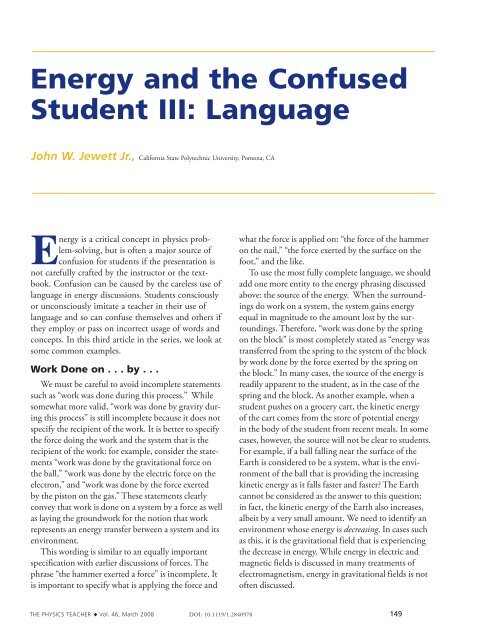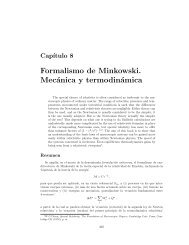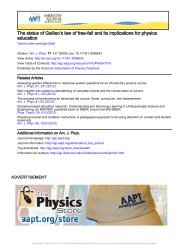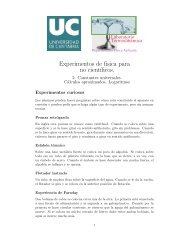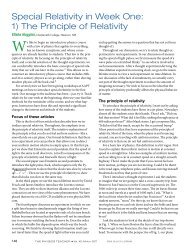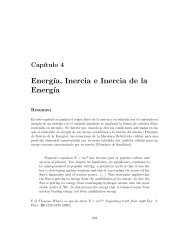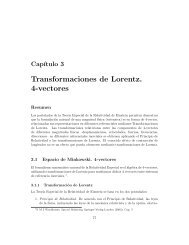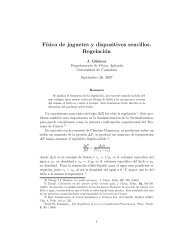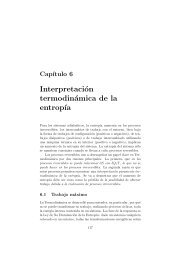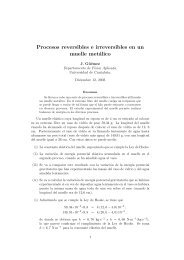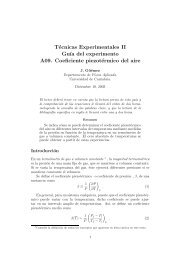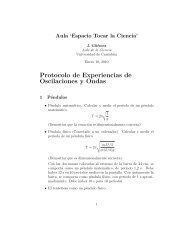Energy and the Confused Student III: Language - Loreto-Unican
Energy and the Confused Student III: Language - Loreto-Unican
Energy and the Confused Student III: Language - Loreto-Unican
- No tags were found...
Create successful ePaper yourself
Turn your PDF publications into a flip-book with our unique Google optimized e-Paper software.
<strong>Energy</strong> <strong>and</strong> <strong>the</strong> <strong>Confused</strong><strong>Student</strong> <strong>III</strong>: <strong>Language</strong>John W. Jewett Jr., California State Polytechnic University, Pomona, CA<strong>Energy</strong> is a critical concept in physics problem-solving,but is often a major source ofconfusion for students if <strong>the</strong> presentation isnot carefully crafted by <strong>the</strong> instructor or <strong>the</strong> textbook.Confusion can be caused by <strong>the</strong> careless use oflanguage in energy discussions. <strong>Student</strong>s consciouslyor unconsciously imitate a teacher in <strong>the</strong>ir use oflanguage <strong>and</strong> so can confuse <strong>the</strong>mselves <strong>and</strong> o<strong>the</strong>rs if<strong>the</strong>y employ or pass on incorrect usage of words <strong>and</strong>concepts. In this third article in <strong>the</strong> series, we look atsome common examples.Work Done on . . . by . . .We must be careful to avoid incomplete statementssuch as “work was done during this process.” Whilesomewhat more valid, “work was done by gravity duringthis process” is still incomplete because it does notspecify <strong>the</strong> recipient of <strong>the</strong> work. It is better to specify<strong>the</strong> force doing <strong>the</strong> work <strong>and</strong> <strong>the</strong> system that is <strong>the</strong>recipient of <strong>the</strong> work: for example, consider <strong>the</strong> statements“work was done by <strong>the</strong> gravitational force on<strong>the</strong> ball,” “work was done by <strong>the</strong> electric force on <strong>the</strong>electron,” <strong>and</strong> “work was done by <strong>the</strong> force exertedby <strong>the</strong> piston on <strong>the</strong> gas.” These statements clearlyconvey that work is done on a system by a force as wellas laying <strong>the</strong> groundwork for <strong>the</strong> notion that workrepresents an energy transfer between a system <strong>and</strong> itsenvironment.This wording is similar to an equally importantspecification with earlier discussions of forces. Thephrase “<strong>the</strong> hammer exerted a force” is incomplete. Itis important to specify what is applying <strong>the</strong> force <strong>and</strong>what <strong>the</strong> force is applied on: “<strong>the</strong> force of <strong>the</strong> hammeron <strong>the</strong> nail,” “<strong>the</strong> force exerted by <strong>the</strong> surface on <strong>the</strong>foot,” <strong>and</strong> <strong>the</strong> like.To use <strong>the</strong> most fully complete language, we shouldadd one more entity to <strong>the</strong> energy phrasing discussedabove: <strong>the</strong> source of <strong>the</strong> energy. When <strong>the</strong> surroundingsdo work on a system, <strong>the</strong> system gains energyequal in magnitude to <strong>the</strong> amount lost by <strong>the</strong> surroundings.Therefore, “work was done by <strong>the</strong> springon <strong>the</strong> block” is most completely stated as “energy wastransferred from <strong>the</strong> spring to <strong>the</strong> system of <strong>the</strong> blockby work done by <strong>the</strong> force exerted by <strong>the</strong> spring on<strong>the</strong> block.” In many cases, <strong>the</strong> source of <strong>the</strong> energy isreadily apparent to <strong>the</strong> student, as in <strong>the</strong> case of <strong>the</strong>spring <strong>and</strong> <strong>the</strong> block. As ano<strong>the</strong>r example, when astudent pushes on a grocery cart, <strong>the</strong> kinetic energyof <strong>the</strong> cart comes from <strong>the</strong> store of potential energyin <strong>the</strong> body of <strong>the</strong> student from recent meals. In somecases, however, <strong>the</strong> source will not be clear to students.For example, if a ball falling near <strong>the</strong> surface of <strong>the</strong>Earth is considered to be a system, what is <strong>the</strong> environmentof <strong>the</strong> ball that is providing <strong>the</strong> increasingkinetic energy as it falls faster <strong>and</strong> faster? The Earthcannot be considered as <strong>the</strong> answer to this question;in fact, <strong>the</strong> kinetic energy of <strong>the</strong> Earth also increases,albeit by a very small amount. We need to identify anenvironment whose energy is decreasing. In cases suchas this, it is <strong>the</strong> gravitational field that is experiencing<strong>the</strong> decrease in energy. While energy in electric <strong>and</strong>magnetic fields is discussed in many treatments ofelectromagnetism, energy in gravitational fields is notoften discussed.The Physics Teacher ◆ Vol. 46, March 2008 DOI: 10.1119/1.2840978 149
Potential <strong>Energy</strong>In discussions of potential energy, a commonmisleading practice is to use a phrase such as <strong>the</strong> “potentialenergy of <strong>the</strong> ball,” in which potential energyis associated with an object ra<strong>the</strong>r than with a systemof two or more interacting objects. This is misleadingconceptually <strong>and</strong> ignores <strong>the</strong> importance of <strong>the</strong> system,as discussed in <strong>the</strong> second article in this series. 1 Itis important to stress that potential energy is a propertyof a system, not an object. It is associated with aforce that acts between members of <strong>the</strong> system so itcannot be associated with one member only—a singleobject cannot possess potential energy. 2 Therefore, <strong>the</strong>better phrase for gravitational potential energy is <strong>the</strong>“potential energy of <strong>the</strong> ball-Earth system.”Ano<strong>the</strong>r common misleading statement is to saythat potential energy is related to <strong>the</strong> positions ofobjects that are interacting within a system. This isa claim that causes little or no trouble in simple mechanicsproblems but must be revised later on when<strong>the</strong> student studies electromagnetism. Imagine anelectric dipole in an electric field or a magnetic dipolein a magnetic field, ei<strong>the</strong>r of which can be rotatedwithout a change in position. Even though <strong>the</strong> positionof <strong>the</strong> center of <strong>the</strong> rotating dipole remainsunchanged, <strong>the</strong> potential energy of <strong>the</strong> dipole–fieldsystem changes. This change is caused by a change in<strong>the</strong> orientation of <strong>the</strong> dipole, not a change in position.Consequently, it sets <strong>the</strong> stage for future possibilitiesto discuss in mechanics that potential energy is associatedwith <strong>the</strong> configuration of interacting objects in asystem. This allows for changes in both position <strong>and</strong>orientation.In a related issue, a common statement in mechanicsis that <strong>the</strong> “potential energy is zero at <strong>the</strong> bottom of<strong>the</strong> ramp.” This suggests that potential energy is likea field, having a unique value at all points in space. Itis more proper to say that <strong>the</strong> “potential energy is zerofor <strong>the</strong> configuration of <strong>the</strong> system in which <strong>the</strong> car isat <strong>the</strong> bottom of <strong>the</strong> ramp.”HeatMoving to <strong>the</strong>rmodynamics, we find <strong>the</strong> mostmisused physics word in popular language—heat. Itis important to stress that physicists use this word torefer to (1) a process by which energy is transferred <strong>and</strong>(2) <strong>the</strong> amount of energy transferred by this process,normally denoted as Q. It is not <strong>the</strong> entity that is beingtransferred (heat is not transferred; it is energy that istransferred) <strong>and</strong>, even worse, it is not <strong>the</strong> energy contentof a system with a temperature (correctly describedas internal energy). Romer 3 claims that heat shouldnot be used as a noun. While I agree with <strong>the</strong> spirit ofusing <strong>the</strong> word heat correctly, I disagree that heat is nota noun. Heat is indeed a noun, but it is <strong>the</strong> name of aprocess, not <strong>the</strong> name of what is transferred. Bauman 4has also discussed <strong>the</strong> use of <strong>the</strong> word heat <strong>and</strong> its interpretationas temperature <strong>and</strong> internal energy.Consider some phrases used in common language:“heat transfer,” “flow of heat,” <strong>and</strong> “<strong>the</strong> heat radiatedoutward.” These phrases refer to a transfer of energybut represent incorrect uses of <strong>the</strong> word heat. Thephrases can be tested by substituting <strong>the</strong> words “energytransfer” for “heat.” Each phrase sounds awkwardor redundant when this is done. For example, “heattransfer” becomes “energy transfer transfer.” O<strong>the</strong>rcommon phrases include “<strong>the</strong> heat of <strong>the</strong> day” <strong>and</strong>“too much heat in <strong>the</strong> air.” In <strong>the</strong>se uses, heat is beingused to represent temperature. Ano<strong>the</strong>r commonstatement is “heat rises.” In this case, heat is used tomean warm air!Barrow 5 makes a radical suggestion that <strong>the</strong> wordswork <strong>and</strong> heat should “vanish from <strong>the</strong> <strong>the</strong>rmodynamicsscene.” He stresses that <strong>the</strong>rmodynamics shouldfocus on energy, <strong>and</strong> not on work <strong>and</strong> heat. I wholeheartedlyagree that <strong>the</strong>rmodynamics should focus onenergy; in fact, all branches of physics should focuson energy as <strong>the</strong> entity that is being transferred. Idisagree, however, that we should rid ourselves of <strong>the</strong>words work <strong>and</strong> heat. I think students clearly see a differencebetween (1) applying a force on a system <strong>and</strong>(2) placing a cold system in a warm environment, <strong>and</strong>we need words to differentiate <strong>the</strong>se two very differentsituations.While it is not likely that we can turn societyaround in its use of <strong>the</strong> word heat, we can strive tohave a fraction of <strong>the</strong> population, our students, using<strong>the</strong> word correctly. For <strong>the</strong> case in which energymoves between a system at one temperature <strong>and</strong> itssurroundings at a different temperature, <strong>the</strong> processthat occurs is “energy transfer by heat.” I dislike <strong>the</strong>slightly different phrasing “energy transfer in <strong>the</strong> formof heat” because this suggests that heat is a form of energystorage ra<strong>the</strong>r than a method of energy transfer.150 The Physics Teacher ◆ Vol. 46, March 2008
<strong>Energy</strong> Transfer <strong>and</strong> TransformationFollowing on <strong>the</strong> discussion of <strong>the</strong> importance of<strong>the</strong> system in <strong>the</strong> second article 1 in this series, let usnow discuss <strong>the</strong> important distinction between transferof energy <strong>and</strong> transformation of energy. One populartextbook 6 states that (1) energy is transferred fromkinetic energy to gravitational potential energy. Thisis an example of a statement that confuses students,especially when compared to an earlier statement in<strong>the</strong> same textbook that states that (2) energy can betransformed from one type to ano<strong>the</strong>r <strong>and</strong> transferredfrom one object to ano<strong>the</strong>r. Statement (2) is correct,albeit incomplete (<strong>the</strong> emphasis is on an object ra<strong>the</strong>rthan a system), but statement (1) is incorrect.It should be made clear to students that transformationsof energy occur within a system <strong>and</strong> result in oneform of energy storage changing to ano<strong>the</strong>r. For example,in a ball-Earth system, <strong>the</strong> kinetic energy of <strong>the</strong>system as <strong>the</strong> thrown ball rises upward is transformedto gravitational potential energy of <strong>the</strong> system. In thiscommon situation, <strong>the</strong> kinetic energy of <strong>the</strong> system isassociated with only one moving object (in <strong>the</strong> referenceframe of <strong>the</strong> Earth), but in general, it is <strong>the</strong> energyof <strong>the</strong> entire system that is transformed. In a stickof dynamite, chemical potential energy transforms tointernal energy <strong>and</strong> kinetic energy of shattered pieceswhen <strong>the</strong> stick explodes. When a block slides across afloor <strong>and</strong> stops, kinetic energy of <strong>the</strong> block-floor systemis transformed to internal energy in <strong>the</strong> block <strong>and</strong>floor. If <strong>the</strong> system is isolated, only transformationsof energy can occur <strong>and</strong> <strong>the</strong> total energy of <strong>the</strong> systemremains constant.In contrast, transfers of energy occur across <strong>the</strong>system boundary <strong>and</strong> can result in a change in <strong>the</strong>total energy of <strong>the</strong> system. These transfer mechanismsinclude work, heat, <strong>and</strong> electromagnetic radiation, aswell as o<strong>the</strong>rs that will be discussed in <strong>the</strong> fourth articlein this series. 7Additional careless language includes statementssuch as “energy enters <strong>the</strong> light bulb as electricity <strong>and</strong>turns into light <strong>and</strong> heat.” This statement has threeweaknesses in terms of clarity of language. First, energydoes not enter any electrical device “as electricity.”This suggests that electricity is a form of energy.Similarly, <strong>the</strong> second <strong>and</strong> third weaknesses are relatedto <strong>the</strong> statement that energy “turns into” light <strong>and</strong>heat: because “turns into” is equivalent to “transformsinto,” this statement suggests that light <strong>and</strong> heat arealso forms of energy ra<strong>the</strong>r than mechanisms forenergy transfer. A stronger, more correct statementis that “energy enters <strong>the</strong> system of <strong>the</strong> light bulb byelectrical transmission <strong>and</strong> transfers out of <strong>the</strong> systemby electromagnetic radiation <strong>and</strong> heat.” Notice thatchanging “as” to “by” is an important step in identifyingelectricity, light, <strong>and</strong> heat as transfer mechanismsra<strong>the</strong>r than forms of energy storage.<strong>Energy</strong> Dissipation <strong>and</strong> LossThe study of electric circuits has an example of anunfortunate but popular word choice—energy is “dissipatedin a resistor.” While physics teachers know thatthis means that <strong>the</strong> resistor warms up <strong>and</strong> energy istransferred to <strong>the</strong> environment by heat <strong>and</strong> radiation,students may interpret this word to mean that energyis disappearing. One dictionary definition of dissipateis “to cause to spread out to <strong>the</strong> point of vanishing.”The student can apply this notion <strong>and</strong> come up with<strong>the</strong> idea that <strong>the</strong> energy is vanishing in some way.It is better to say that energy is delivered to <strong>the</strong> resistor,which reinforces <strong>the</strong> notion of energy transfer toa system. Because of this transfer, <strong>the</strong> internal energyof <strong>the</strong> resistor increases. In turn, <strong>the</strong>re is typically asubsequent transfer of energy by heat <strong>and</strong> electromagneticradiation from <strong>the</strong> warm resistor to <strong>the</strong> coolerenvironment.A similar wording that appears in textbooks is“loss” of energy. This is dangerous territory for studentconfusion, especially when energy has been correctlyintroduced earlier in <strong>the</strong>se textbooks by sayingthat energy is nei<strong>the</strong>r created nor destroyed. If energycannot be created nor destroyed, how can it be “lost”?It is far better to be consistent <strong>and</strong> talk about energytransfers <strong>and</strong> transformations <strong>and</strong> to avoid <strong>the</strong> word“loss” completely.Conditions for ValidityAno<strong>the</strong>r important issue related to language usedwhen discussing energy, as well as any topic in physics,is to present physical principles along with <strong>the</strong>conditions for which <strong>the</strong>y are true. For example, inmechanics, it would be meaningless to state “an objectin motion remains in that state of motion” withoutadding <strong>the</strong> condition “for <strong>the</strong> case in which no forcesact on <strong>the</strong> object.”The Physics Teacher ◆ Vol. 46, March 2008 151
situation, but it is not true in general. This type of absolutestatement that does not refer to <strong>the</strong> conditionsshould be avoided because it leads students to believethat, in this case, <strong>the</strong> work-kinetic energy <strong>the</strong>orem is afundamental principle. While <strong>the</strong> statement is true fora situation in which a horizontal force is applied to anobject on a horizontal frictionless surface, it becomesfalse when <strong>the</strong> surface has friction or in any case inwhich <strong>the</strong> work done on a system does not result ina change in <strong>the</strong> speed, such as lifting a book from alower shelf <strong>and</strong> placing it on a higher shelf.ConclusionThere are many places where we can lead ourstudents into misinterpretations by careless use oflanguage. Careful <strong>and</strong> correct use of terms <strong>and</strong> definitionscan go far in improving our students’ conceptualunderst<strong>and</strong>ing <strong>and</strong> problem-solving ability. In <strong>the</strong>next article in this series, we will discuss a global approachto energy that can be used to address any energyproblem.6. As a textbook author myself, I do not specifically identifyproblematic statements in o<strong>the</strong>r authors’ textbooksin this series of articles. I do not want this series to appearas a marketing tool, but ra<strong>the</strong>r as a professionalcommunication that offers a set of suggestions for improving<strong>the</strong> teaching of energy to our students. I presentitems from several textbooks in general terms <strong>and</strong>not as direct quotes.7. J.W. Jewett, “<strong>Energy</strong> <strong>and</strong> <strong>the</strong> confused student IV: Aglobal approach to energy,” Phys. Teach., to be publishedin April 2008.8. R. Baierlein, “Does nature convert mass into energy?”Am. J. Phys. 75, 320–325 (April 2007).PACS codes: 01.40.gb, 45.00.00John W. Jewett Jr. is professor emeritus at CaliforniaState Polytechnic University. He has authored The Worldof Physics; Mysteries, Magic, <strong>and</strong> Myth <strong>and</strong> co-authoredPhysics for Scientists <strong>and</strong> Engineers, seventh edition, <strong>and</strong>Principles of Physics, fourth edition. He won <strong>the</strong> AAPTExcellence in Undergraduate Physics Teaching Award in1998; jwjewett@csupomona.eduReferences1. J.W. Jewett, “<strong>Energy</strong> <strong>and</strong> <strong>the</strong> confused student II: Systems,”Phys. Teach. 46, 81–86 (Feb. 2008).2. This statement is made under <strong>the</strong> assumption that weignore internal structure of <strong>the</strong> object. Objects withinternal structure can possess potential energy. Forexample, a spring can possess elastic potential energy<strong>and</strong> a can of gasoline can possess chemical potentialenergy. These types of energy are associated with forcesbetween components of <strong>the</strong> structure of <strong>the</strong> object,however, not with forces between <strong>the</strong> object <strong>and</strong> o<strong>the</strong>robjects.3. R.H. Romer, “Heat is not a noun,” Am. J. Phys. 69,107–109 (Feb. 2001).4. R.P. Bauman, “Physics that textbook writers usually getwrong: II. Heat <strong>and</strong> energy,” Phys. Teach. 30, 353–356(Sept. 1992).5. G.M. Barrow, “Thermodynamics should be built onenergy—Not on heat <strong>and</strong> work,” J. Chem. Educ. 65(2),122–125 (Feb. 1988).The Physics Teacher ◆ Vol. 46, March 2008 153


